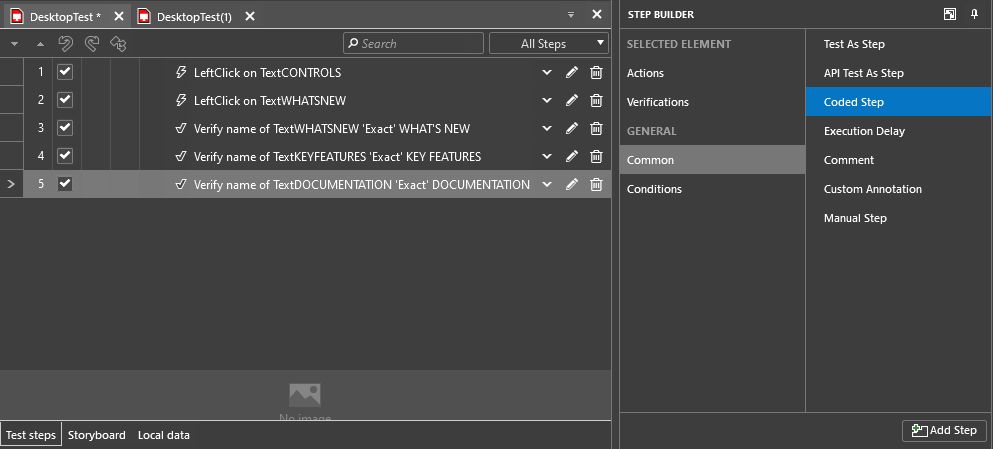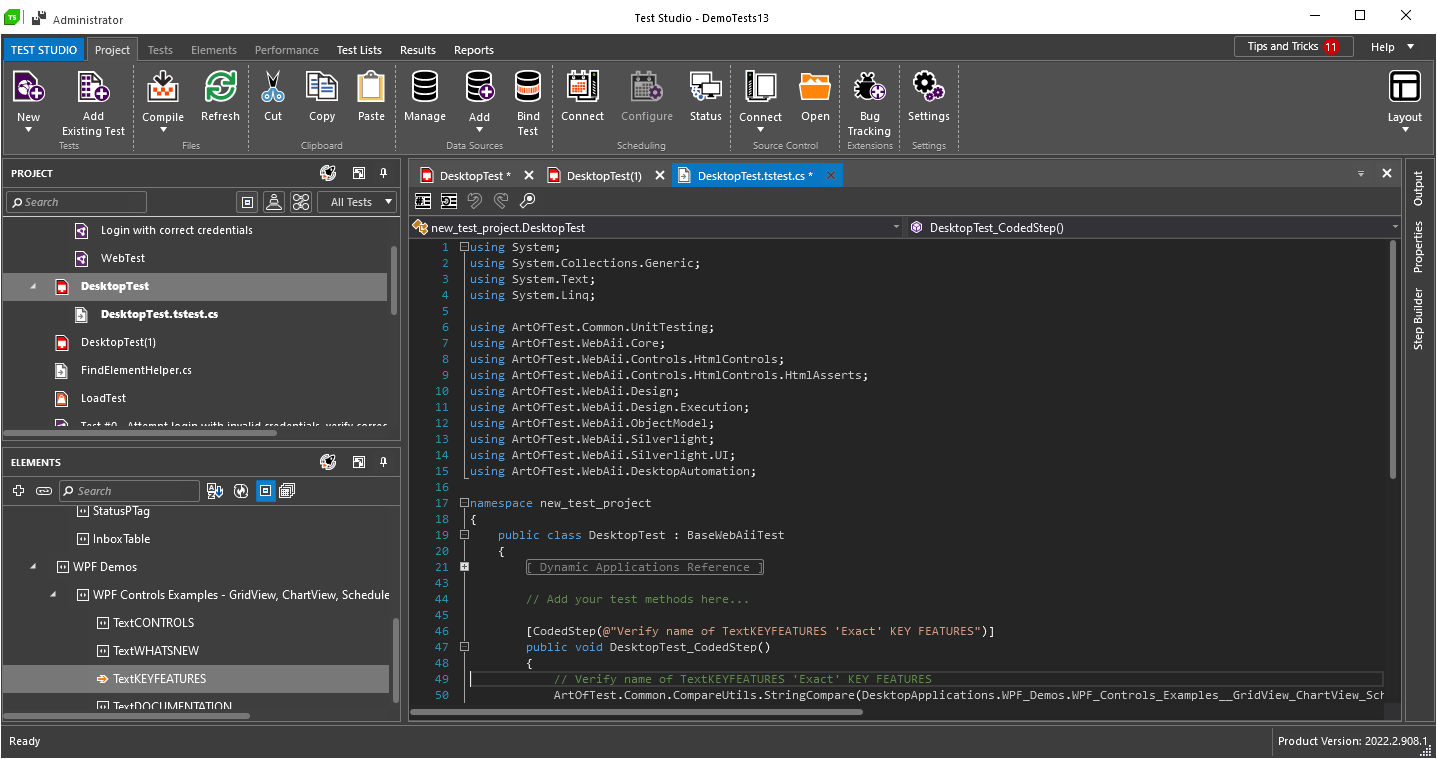
Test Studio
What's New R3 2022
What's New HistoryDesktop Test Automation Official Release
Test Studio R3 2022 helps you accelerate application delivery, supporting both small- and large-scale automation shops, and covering all your web and desktop testing needs across a wide range of technologies and frameworks
R3 2022 introduces the first official version of the desktop test automation feature set, which was launched as a Beta. With this release and the features, it ships with, desktop testing is getting closer to Test Studio’s industry-leading feature set for web testing. While the focus of the Beta was to provide the users with access to Test Studio’s core features for functional desktop testing and extensive desktop technology coverage, R3 2022 brings advanced automation capabilities for a holistic desktop testing approach. These include:
Visual Test Recorder
The Test Recorder is getting feature updates for advanced desktop test recording. Besides the quick action and verification steps available in the Recorder, it now gives you access to the Advanced Recording Tools with a lot more features for your desktop test scenarios.

Advanced Recording Tools
The Advanced Recording Tools – one of Test Studio’s most loved features for web testing – is now available for Desktop with DOM Explorer and Common Steps. The DOM Explorer allows you to inspect elements in the DOM Tree and build steps for these elements. You can also take advantage of all available Common Steps such as Test as Step, API Test as Step, Coded Step, Delay, Custom Annotation, Manual Steps, etc.

Step Builder
Test Studio now allows you to build steps from the Step Builder. Steps can be added to pre-recorded tests to enhance the automation workflow you’ve recorded, e.g. add Execution Delay or build in all sorts of additional verifications. This feature is very useful when you’ve recorded your test but then need to edit or maintain it to make it more stable and sustainable over time. On top of that, the Step Builder can be accessed “offline” with no app or with an active app running. When used in an “offline” mode, outside of a recording session, the Step Builder allows you to add Quick Actions and Mouse Actions for elements that are stored in the Element Explorer. Previously, these were only available during recording with the Test Recorder.

Desktop Test Automation in Visual Studio
All core Desktop testing features that Test Studio provides are now available in the Visual Studio Plugin as well. Record tests, add code, easily maintain your scripts with the help of the centralized Element Repository, add steps through the Step Builder and run your automation through the test lists. All of this is in Visual Studio and in Test Studio's Standalone IDE.
Code Editor in Test Studio Standalone IDE and Visual Studio Plugin
One of Test Studio’s features that more experienced testers take great advantage of is its ability to edit any automated test in code or enhance already recorded tests with coded steps. With R3 this is possible also for Desktop, both in the Standalone application and within Visual Studio through the Test Studio Plugin for Visual Studio using C#. Test engineers will be able to record desktop tests directly in Visual Studio and utilize Test Studio’s advanced coding capabilities to solve any test scenario they face.

Configure APP for automation by Application User Model ID
Another feature that will significantly enhance the experience of test engineers with desktop testing in Test Studio is the option to configure Application User Model ID as an alternative option to provide an installation path to an app. This feature offers tremendous flexibility for users dealing with modern Windows App testing, including MAUI-based applications, which is a whole new testing world to explore. By configuring a Windows App for automation by Application Uсer Model ID, testers can set up Test Studio to access such applications a lot easier and faster, saving tons of time and enjoying a straightforward approach, without redundancies and automation hurdles.
Test Stability Improvements
A new AI-infused mechanism greatly improves test stability in web testing with Test Studio, especially when the tests run on slow machines. The mechanism makes sure that elements are visible and correctly rendered on a page before running a test. This enhancement reduces test maintenance tremendously by avoiding random failures in both headless and headed-UI test execution on slow machines.
Extensionless Test Automation in Chrome and Edge
On September 23, 2021, Google announced that effective from January 2023, third-party MV2 extensions (Manifest V2) will no longer be supported and allowed to run in Chrome. There are certain security exceptions in MV2 which enable extensions to plug into web applications. This is how most test automation tools gain access to the application under test to perform actions and verifications with it. Therefore, this major update in Chrome extension policy affects the commercial test automation tools that require the installation of an extension for in-browser automation.
The Test Studio team has anticipated this change and has already provided the solution while keeping and improving the existing extension-based feature set and user experience - test automation without extension. Extensionless test automation is a fact in the latest Test Studio releases, not only getting ahead of Google’s change but bringing additional benefits to your automation suites like simplified environment setup, fewer security concerns, and faster test execution.
As of R3 2022, Extensionless testing will be turned on by default for all newly created projects.

New features & Roadmap
Have a feature request?
Post your feedback via the Test Studio UserVoice portal or the Public forums
What's new across all Telerik products?

Next Steps
Hosted by our product experts.
Check out the offers.
With dedicated technical support.


